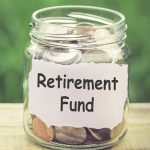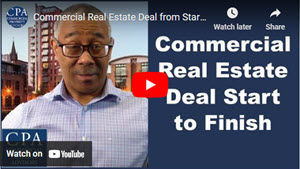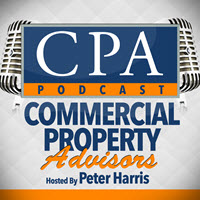
Do you have retirement savings built up that will last all the way to the end? Are you getting older and haven’t been able to put money aside for retirement? Perhaps life has gone by and you were too busy to focus on it. Maybe you are going through a difficult time financially, or lost your retirement savings and are starting over.
Whatever your situation, in this post you will learn how you can catch up on your retirement savings with commercial real estate. You’ll discover how Protégé Program member Jim was able to purchase his first commercial property and earn $2,400 per month, investing only $60,000 upfront for the investment as well as creating an additional $400,000 in equity! The same process that Jim used can be repeated by anyone in search of a financially secure retirement.
Growth, Stability and Security
Many people make the mistake of investing in risky investments like restaurants, a relative’s farfetched start up company, or they spend their money on jewelry and cars. They end up losing money and have nothing left for retirement. They should be investing in something with growth and that is stable and secure. Most importantly, in something tangible, that you can measure the worth of in real time and cashflow. You need investments that produce the type of cashflow that puts money in your pocket to buy groceries, pay the mortgage and support your family.
Catch Up on Your Retirement Savings with Commercial Real Estate
Commercial real estate can help you make up for a lost time in your retirement savings and lead to a financially secure retirement. When Jim, one of our Protégés approached us, his dilemma was that he was in his sixties and didn’t have adequate retirement savings. He had a goal of retiring in three years, but he didn’t even have a retirement plan. With our coaching, and twelve months of hard work and focus, he was able to create a $400,000 nest egg that’s providing him cashflow and is still growing.
Can You Save Enough for Retirement?
I was reading a New York Times article that would cause one to wonder. It claimed that if you’re in your sixties with $1 million invested in municipal bonds, and begin to withdraw 4% per year when you retire, there’s a 72% probability that you’ll deplete your savings before you die. We need a better solution than this.
The Solution is Commercial Real Estate
I believe commercial real estate is the best vehicle for retirement planning. It has six investor controls that other investments lack and these investor tools are necessary in any retirement plan.
Six Investor Controls:
- Management: When investing in commercial real estate, you control who manages your property. You have a say in the day to day operations, ensuring that your money is safe and your investment is working for you. No controversy is going to take the company down and affect your investment. You have control over the management.
- Insurance: What happens if there is a catastrophe that totally levels your commercial property? With your insurance, you can fully recover that property and rebuild even better than before at no cost to you.
- Predictability: In commercial real estate there is a market and not just one piece of property. You can see volatility happening months in advance which enables you to be proactive. If you hear of something happening in that neighborhood and market, you can react now and adjust before it happens. There’s predictability in commercial real estate that you don’t have in other investments.
- Leverage: You can buy a $1 million property, not for $1 million, but with 25% of that. If the investor in that New York Times article had taken his $1 million and purchased a $4 million commercial property, his cash flow would be two or three times more than what he was drawing from his $1 million in savings. That is an example of leverage.
- Tax Advantages: How does a company like Amazon get away with paying no income taxes? They strategize accordingly, and they pay little or no income tax. Even though you own something small in comparison, you get the same legal loopholes and tax advantages as Amazon. In fact, recent tax incentives from the White House just made real estate investing even better. Tax advantages are an investor control that you get investing in commercial real estate but would not get when investing in stocks.
- Cashflow: You get to control the cashflow, which is the lifeblood of business when thinking about retirement. If you manage your commercial property well you increase the cashflow. When investing in stock, no matter how well you do, you have no control of the cashflow. It’s in someone else’s hands. Cashflow control is critical when considering a retirement plan.
Jim’s Problem
Jim is getting older and nearing retirement. He has some money saved, but not nearly enough to retire in three years, and he has no retirement plan.
The Solution
In our coaching, we had Jim focus on commercial properties where the owner was out of state because we believe these owners are more motivated sellers and easier to deal with. At Commercial Property Advisors, we are good at helping locate these properties, although almost anyone can find them if they know where to look. However, what do you do when you find them? We train our proteges how to build rapport, ask the right questions, evaluate and find motivations, and discover what’s going on with the seller. This enables them to structure the best deal, and that is how we trained Jim.
The Property
Jim found an eight-unit property that was horribly mismanaged. The owner was out of state and in distress, and the property manager was taking advantage of her. We made an offer for $500,000, which was the asking price. The offer was accepted, however we discovered that the property was in worse condition than we originally thought, reducing the price to $450,000. At that time, we had contractors come in and assess the property. Discovering some structural issues and with more detailed quotes, we decided we couldn’t pay more than $385,000. We went back to the seller assuming she would say no. She disappeared for a few months, but we kept at her and eventually she agreed to $385,000.
Financing
We proceeded with the deal and Jim found financing. He found an 80% loan. This means the lender will loan him 80% of the acquisition costs; the $385,000 plus 80% of the renovation costs, which were $65,000. We thought this was great.
Unexpectedly, the appraisal came in at $350,000, so it was $35,000 short from the agreed upon sales price. That forced us to go back to the seller to re-negotiate. The extra $35,000 just wasn’t worth it for Jim, so we had to draw a line in the sand and thought the deal was dead. To our surprise she agreed to the new price. In her mind she had already closed this deal and moved on so she agreed to $350,000.
Upside Potential
When doing our due diligence, we discovered that the property had some good upside potential. We discovered a comparable apartment complex for $1 million. That means buying this for $350,000 with a reno budget of $65,000 is a pretty good deal. We also did a market rent survey and found out that the rents of all the units were considerably under market because of the poor management and the condition of the property.
The Execution
This is when the real work begins. We did 3 things:
- Evictions
- Renovations
- Increased the rents after the renovations
Increased Property Value
- Jim started off with a net operating income of $26,000 per year.
- After six months, he more than doubled the NOI to $57,000 per year.
For commercial property, as the NOI goes up so does the property value. Jim was able to get a substantial increase in property value.
How Do We Calculate the Property Value?
We can calculate the value of a commercial property by dividing the NOI by the market cap rate.
- His all in was $415, 000; the $350,000 plus the $65,000 of renovations.
- The NOI is $57,000 a year, divided by the market cap rate of 7%, is $814,000. His new property value is $814,000, which is an increase of close to $400,000 in equity.
- The cashflow starting off was about $700 a month, but today is at $2,600 a month.
Read my post on Value-Add Commercial Real Estate to learn more about this concept.
Exit Strategy
Every good deal has an exit strategy and is repeatable. Jim has another deal that he wants to do, but he doesn’t have the money. The plan is to wait for his NOI to mature and then when the lender revalues the property, he will do a cash out refinance and pull out some of the equity. In Jim’s case he will be able to pull out his entire down payment and put that into another property.
Watch my video Secrets to Refinancing Commercial Real Estate to learn more
Jim closed a great deal with all the investor controls in place. He accomplished his goal of retiring in three years by creating a $400,000 nest egg and increasing his cashflow.
3 Questions to Ask Yourself
1. Do I have money working towards my retirement and creating cashflow?
2. Am I playing catch up?
3. Am I willing to play a bigger game of commercial real estate?
Hopefully, the answer is yes. All it may take is one good commercial deal to put you on the path to a financially secure retirement.



